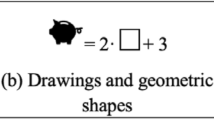Abstract
Sixty-five undergraduates were tested on five formal thinking tasks and the verbal and figural sections of the Torrance Tests of Creative Thinking. The percentage of students operating at the formal level for three of the four ordinally scored formal problems was significantly above the 50% figure usually reported with a more intellectually representative sample of adolescents. It was suggested that the norms developed by Piaget for formal tasks were more suitable for a cognitively superior population. The low intercorrelations between formal tasks were reflected by the failure of a unified factor of the formal operations to emerge. The superior male performance on formal tasks was interpreted in terms of a social role hypothesis and the limited scientific subject matter of the problems.
Similar content being viewed by others
References
Brainerd, C. J. (1971). The construction of the formal operations of implication-reasoning and proportionality in children and adolescents. Doctoral dissertation, Michigan State University. University Microfilms, Ann Arbor, Mich., No. 71-11, 792.
Case, D., and Collinson, J. M. (1962). The development of formal thinking in verbal comprehension.Brit. J. Educ. Psychol. 57:103–111.
Cooley, W. W., and Lohnes, P. R. (1962).Multivariate Procedures for the Behavioral Sciences, Wiley, New York.
Elkind, D. (1961). Children's discovery of the conservation of mass, weight, and volume: Piaget replication study II.J. Genet. Psychol. 98:219–227.
Elkind, D. (1962). Quantity conceptions in college students.J. Soc. Psychol. 57:459–465.
Elkind, D. (1966). Conceptual orientation shifts in children and adolescents.Child Develop. 37:493–498.
Field, T. W., and Cropley, A. J. (1969). Cognitive style and science achievement.J. Res. Science Teaching 6:2–10.
Higgins-Trenk, A., and Gaite, A. J. (1971). Elusiveness of formal operational thought in adolescents. Paper presented at the meeting of the American Psychological Association, Washington, D.C., September 1971.
Hughes, M. M. (1965). A four-year longitudinal study of the growth of logical thinking in a group of secondary modern schoolboys. Unpublished master's thesis, University of Leeds.
Inhelder, B., and Piaget, J. (1958).The growth of Logical Thinking from Childhood to Adolescence, Basic Books, New York.
Jackson, S. (1963). The growth of logical thinking in normal and subnormal children. Unpublished master's thesis, University of Manchester.
Kaiser, H. F. (1960). The application of electronic computers to factor analysis.Educ. Psychol. Meas. 19:413–420.
Lovell, K. (1971). Some problems associated with formal thought and its assessment. In Green, D. R., Ford, M. P., and Flamer, G. B. (ed.),Measurement and Piaget, McGraw-Hill, New York.
Lovell, K., and Shields, J. B. (1967). Some aspects of the study of the gifted child.Brit. J. Educ. Psychol. 37:201–208.
Neimark, E. A. (1970). A preliminary search for the formal operations structures.J. Genet. Psychol. 116:223–232.
Piaget, J. (1972). Intellectual evolution from adolescence to adulthood.Human Develop. 15:1–12.
Ross, R. J. (1972). The empirical status of the formal operations. Unpublished manuscript, Mississippi State University.
Shouksmith, G. (1970).Intelligence, Creativity and Cognitive Style, Wiley, New York.
Tisher, R. P. (1962). The development of some science concepts: A replication of Piaget's studies with pupils in a New South Wales country high school. Unpublished B.A. (honors) thesis, University of New England, Armidale, New South Wales.
Tisher, R. P. (1971). A Piagetian questionnaire applied to pupils in a secondary school.Child Develop. 42:1633–1636.
Tomlinson-Keasey, C. (1972). Formal operations in females from eleven to fifty-four years of age.Develop. Psychol. 6:364.
Veldman, D. J. (1967).Fortran Programming for the Behavioral Sciences, Holt, New York.
Author information
Authors and Affiliations
Rights and permissions
About this article
Cite this article
Ross, R.J. Some empirical parameters of formal thinking. J Youth Adolescence 2, 167–177 (1973). https://doi.org/10.1007/BF02214093
Received:
Issue Date:
DOI: https://doi.org/10.1007/BF02214093




